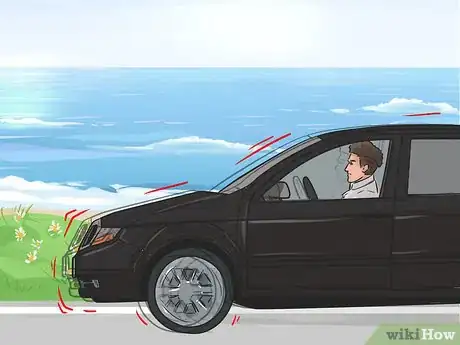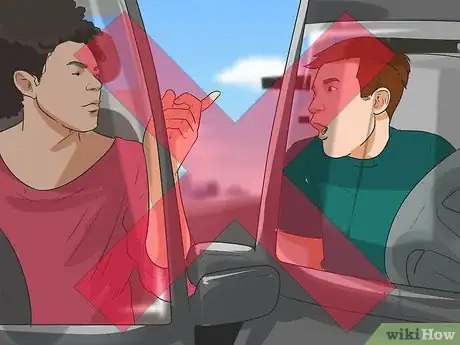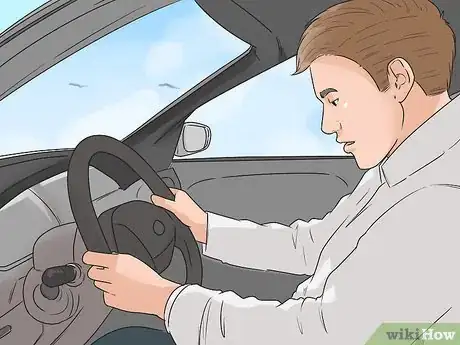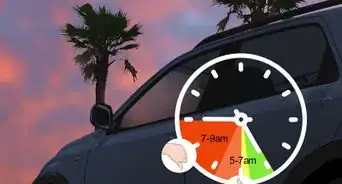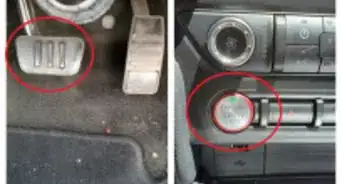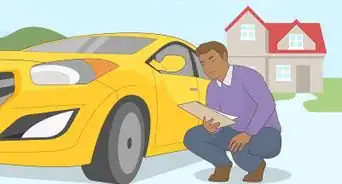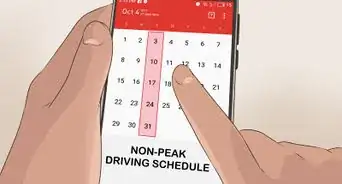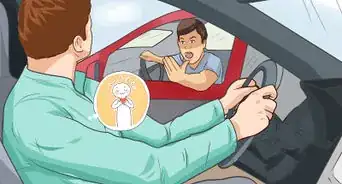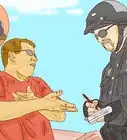This article was co-authored by Ibrahim Onerli. Ibrahim Onerli is a Driving Instructor and the Manager of Revolution Driving School in New York City. His mission is to make the world a better place by teaching safe driving. Ibrahim trains and manages a team of over eight driving instructors. He specializes in teaching defensive driving and stick shift driving.
wikiHow marks an article as reader-approved once it receives enough positive feedback. This article received 16 testimonials and 100% of readers who voted found it helpful, earning it our reader-approved status.
This article has been viewed 238,174 times.
Adopting defensive driving techniques can keep you and others safe on the road. Defensive driving simply means to drive without having a preventable accident. Stay alert, leave enough space between your vehicle and others, and adjust appropriately to any dangerous situations.[1] This will help everyone get to their destinations safely. You may even save money on auto insurance by staying accident-free or by getting certified as a defensive driver!
Steps
Focusing on Driving
-
1Avoid distractions. Defensive driving means focusing on one thing: driving. Make sure that you’re not getting distracted by conversations, the radio, your phone, or anything else. To be as alert as possible, put your phone and other distractions away and turn your radio down. If you’re distracted when talking, don’t participate in conversations until you reach your destination.[2]
-
2Stay alert. Notice things like directional signs, speed limit markers, and signals as you drive. You should also make sure to periodically check your mirrors for a full view of the conditions around your vehicle.[3] Getting into the habit of noticing these thing keeps you alert and ready for anything that comes your way when driving.[4]
- It is very hard to stay alert when driving while sleepy or under the influence. Don’t put yourself and others in danger. Wait until you’re in a better condition, or ask someone else to drive.
Advertisement -
3Look ahead down the road. Instead of just focusing on what’s right in front of your car, make sure to regularly scan farther down the road. That way, you’ll be prepared for what’s to come. Look out for things like:[5]
- Vehicles slowing down in the distance.
- Erratic drivers in either lane.
- Hazards in the road, like fallen limbs or sharp turns.
Responding to Other Drivers
-
1Don’t follow too closely. Keep a distance of 3-4 seconds (or a couple car lengths) between you and the vehicle in front, whenever possible. This buffer gives you more time to react if the driver ahead brakes suddenly or makes some other dangerous move.[6]
- For instance, count "1 independence, 2 independence, 3 independence" when the car in front of you goes by an object. If you pass the same object before you're done counting, slow down a bit.
-
2Observe the rules of right of way. Yield to other drivers when required. If you aren’t sure when to do this, check with your local transportation authority for a refresher on the rules. Being patient and giving other drivers their turn -- even when you’re in a hurry -- helps prevent accidents.
- If you encounter a driver who is not observing the rules of right of way, just let them go. It’s better to wait than to wind up in an accident because another driver was impatient.
-
3Anticipate other drivers’ reactions.[7] You can’t read the minds of other drivers, but you can make an educated guess about how they’re going to act when on the road. Adjust your driving in response to this. For instance, if you’re caught behind a brake-happy driver, leave extra distance between your vehicle and theirs so that you don’t end up rear-ending them.[8]
-
4Don’t resort to road rage.[9] It’s extremely frustrating when other drivers are erratic, don’t follow the rules, or are just plain dangerous. Resist the urge to try to get back at them, however. Getting angry just makes accidents more likely. Take a breath, be patient, and focus on getting to your destination safely.[10]
- For instance, imagine you’re caught behind someone who keeps passing you then slowing down right in front of you. They may just feel like they need to be in front, which can be very frustrating.
- Instead of trying to constantly pass them, too, try moving into another lane, taking an alternate route, or just hanging tight until they’re out of the way.[11]
Reacting to Driving Conditions
-
1Control your speed. Pay attention to posted speed limits, and adjust your driving accordingly. Keeping up with the flow of traffic, whether on a city street or highway, helps avoid accidents. However, if other drivers are moving at dangerously high speeds, don’t attempt to match them. Try to get to a lane where you can stay at a safe speed, out of their way.[12]
-
2Let other drivers know what you’re doing. While you’re staying alert to what others are doing, you’ll also need to help them anticipate your actions. Do everything you can to make yourself visible to other drivers, and to signal when you are turning, braking, etc.[13]
- Check your turn signals, brake lights, and headlights regularly. Use them consistently so that other drivers can see what you’re doing. For instance, try to signal approximately half a block in advance when you plan to turn.[14]
- Avoid blind spots: Don't linger in areas where the driver in front of you can't see you in their mirrors or through their windows.
-
3Adjust your driving based on weather conditions. Rain, fog, snow, ice, wind, mud and other weather features all impact driving. In rough weather or dangerous conditions, you’ll want to do things like:
- Slow down
- Leave extra space between your vehicle and others
- Turn on your lights if it is hard to see
- Be extra careful with turns and steep roads
- Pull over if it feels too dangerous to drive
Expert Q&A
-
QuestionWhat can I do to make myself a more defensive driver?
 Ibrahim OnerliIbrahim Onerli is a Driving Instructor and the Manager of Revolution Driving School in New York City. His mission is to make the world a better place by teaching safe driving. Ibrahim trains and manages a team of over eight driving instructors. He specializes in teaching defensive driving and stick shift driving.
Ibrahim OnerliIbrahim Onerli is a Driving Instructor and the Manager of Revolution Driving School in New York City. His mission is to make the world a better place by teaching safe driving. Ibrahim trains and manages a team of over eight driving instructors. He specializes in teaching defensive driving and stick shift driving.
Driving Instructor Check your mirrors frequently so you're aware of your surroundings. Another thing you can do is activate your turn signals about half a block before you make your turn.
Check your mirrors frequently so you're aware of your surroundings. Another thing you can do is activate your turn signals about half a block before you make your turn. -
QuestionHow do I drive defensively while turning or in round-a-bouts?
 Carl AlldayCommunity AnswerSpeed is key. You need time to judge the movement of traffic both on and about to enter a roundabout. Vehicle positioning is crucial from you and others as this is the strongest signal of your (and others) intentions. Turn indicators are meant to let others know your intentions not confuse. Don't accept every signal, look at their positioning and speed.
Carl AlldayCommunity AnswerSpeed is key. You need time to judge the movement of traffic both on and about to enter a roundabout. Vehicle positioning is crucial from you and others as this is the strongest signal of your (and others) intentions. Turn indicators are meant to let others know your intentions not confuse. Don't accept every signal, look at their positioning and speed. -
QuestionWhat are the qualities of a good driver?
 Community AnswerSome of the qualities of a good driver include having patience with other motorists, being considerate, conscientious, communicative, cooperative, and cautious. A good driver respects the law and avoids confrontation while driving. He or she is licensed, insured, and the vehicle is registered. He or she also drives in a manner that saves lives, time, and money, in spite of the conditions around them or the actions of others.
Community AnswerSome of the qualities of a good driver include having patience with other motorists, being considerate, conscientious, communicative, cooperative, and cautious. A good driver respects the law and avoids confrontation while driving. He or she is licensed, insured, and the vehicle is registered. He or she also drives in a manner that saves lives, time, and money, in spite of the conditions around them or the actions of others.
References
- ↑ Ibrahim Onerli. Driving Instructor. Expert Interview. 18 November 2019.
- ↑ https://www.dmv.org/defensive-driving/defensive-driving-101.php
- ↑ Ibrahim Onerli. Driving Instructor. Expert Interview. 18 November 2019.
- ↑ http://kidshealth.org/en/teens/driving-safety.html
- ↑ https://www.dmv.org/defensive-driving/defensive-driving-101.php
- ↑ http://kidshealth.org/en/teens/driving-safety.html
- ↑ Ibrahim Onerli. Driving Instructor. Expert Interview. 18 November 2019.
- ↑ http://kidshealth.org/en/teens/driving-safety.html
- ↑ Ibrahim Onerli. Driving Instructor. Expert Interview. 18 November 2019.
- ↑ https://www.dmv.org/defensive-driving/defensive-driving-101.php
- ↑ Ibrahim Onerli. Driving Instructor. Expert Interview. 18 November 2019.
- ↑ https://www.dmv.org/defensive-driving/defensive-driving-101.php
- ↑ Ibrahim Onerli. Driving Instructor. Expert Interview. 18 November 2019.
- ↑ Ibrahim Onerli. Driving Instructor. Expert Interview. 18 November 2019.
About This Article
To drive defensively, start by eliminating distractions like your radio and cell phone so that you focus solely on driving. Next, pay attention to the signs, speed limit markers, and signals around you and be sure to scan the entire road ahead, not just what's right in front of you. Also, remember to control your speed and keep a distance of 3-4 seconds between you and the vehicle in front of you. Finally, try to anticipate other drivers' reactions and stay calm around erratic or frustrating drivers to keep yourself safe. For tips on handling driving conditions, read on!



